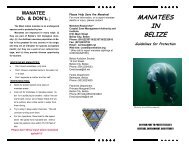The Placencia Lagoon - Coastal Zone Management Authority and ...
The Placencia Lagoon - Coastal Zone Management Authority and ...
The Placencia Lagoon - Coastal Zone Management Authority and ...
You also want an ePaper? Increase the reach of your titles
YUMPU automatically turns print PDFs into web optimized ePapers that Google loves.
<strong>The</strong> turbidity sensor was calibrated with known concentrations of formazine solution.<br />
<strong>The</strong> accuracy of the sensor was ± 2.0 NTU.<br />
<strong>The</strong> depth sensor (a pressure transducer) was regularly calibrated in the field to<br />
compensate for changes in water level, wave height <strong>and</strong> barometric pressure.<br />
Unlike the aforementioned sensors, the temperature sensor is factory calibrated with an<br />
accuracy of ± 0.05 °C hence, there was no need to calibrate this senor in the laboratory or<br />
the field.<br />
Bathymetry<br />
A special field bathymetric survey was conducted on July 18, 2003 in which 202<br />
soundings were recorded in the <strong>Placencia</strong> <strong>Lagoon</strong>. <strong>The</strong> depth measurements were taken<br />
using the pressure transducer installed on the multiparameter sonde <strong>and</strong> the echo sounder<br />
aboard the CZMAI research vessel (Submarine 2). A graduated PVC pipe was used to<br />
measure the depths in extremely shallow but critical parts of the lagoon. As with the<br />
water quality stations, all bathymetric soundings were geo-referenced using the global<br />
positioning system.<br />
Data Analyses<br />
<strong>The</strong> data recorded on paper <strong>and</strong> on the multiparameter sondes were uploaded to<br />
Microsoft Excel worksheets. Using this software, basic mathematical operations were<br />
conducted to prepare several charts <strong>and</strong> tables. Furthermore, water quality variables were<br />
analyzed with descriptive statistics to determine means, ranges, st<strong>and</strong>ard deviation <strong>and</strong><br />
variance.<br />
A non-drift krigging interpolation method was used to create contour maps using Surfer<br />
7.0. Maps of this type illustrate the bathymetry, spatial distribution of temperature <strong>and</strong><br />
salinity within the study area. Considering that most of the data obtained in this research<br />
are geo-referenced data, the final maps <strong>and</strong> graphic illustrations were produced using<br />
ArcView GIS 3.1.<br />
6



